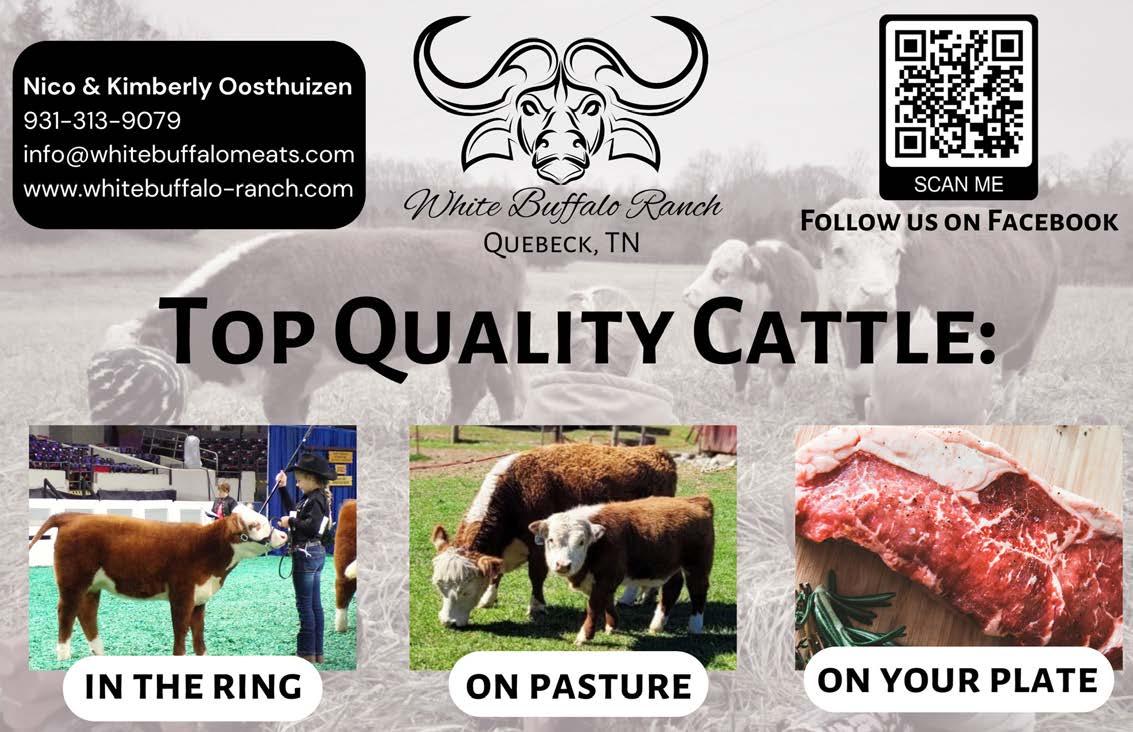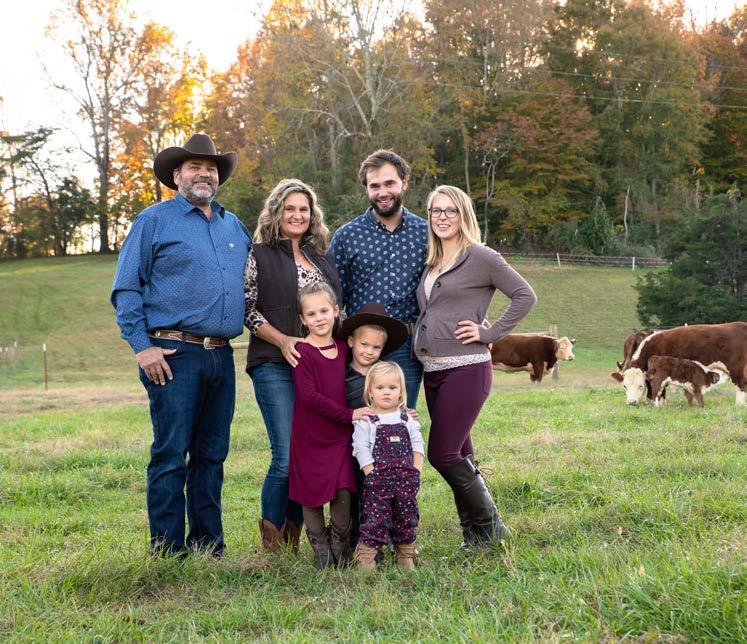
9 minute read
A RANCHERS HAVEN IN THE LAND OF THE FALLING WATER
Tucked into the rolling hills of Quebeck, Tennessee, White Buffalo Ranch embodies resilience, family values, and a commitment to excellence in mini Hereford cattle. Nestled in White County— known as “A Hiker’s Heaven in the Land of Falling Water”—off of Buffalo Road, the ranch thrives in the scenic backdrop of lush pastures and abundant natural resources. Here, the Oosthuizen family has built a legacy rooted in their South African heritage and sustained by a passion for quality breeding and sustainable farming.
----
By Kyle Shipley
The Oosthuizen family’s journey is one of determination and heart. Originally from South Africa, Johan, Marlene, and their son Nico immigrated to America in 2008 for new opportunities. Over time, their dream grew to include Nico’s wife, Kimberly, and their growing family. In 2018, they took a significant step toward self-sufficiency by purchasing 32 acres of fertile pastureland in Tennessee.
At first, the goal was simple: maintain the land. “Hey, we need something to eat the grass!” the family joked. While searching for the perfect “lawnmower,” they discovered mini Herefords through an ad from Buck & Bull Cattle Ranch in Franklin, Tennessee.
Johan’s background in farming, coupled with his prior familiarity with Herefords, made the mini version an ideal fit. They started with one cow and two heifers— and from there, White Buffalo Ranch was born.
“The idea of mini Herefords appealed to us as we were looking for a breed that could be easily managed and interacted with, especially since we have young children. We fell in love with these three creatures,” Kimberly recalls.
From Gateway Livestock To A Growing Herd
For the rest of the family, farming was a brand-new endeavor. “We started with chickens (the ‘gateway livestock’), then added guineas, Boer goats, and finally mini Herefords,” Kimberly shares. While Johan’s time on South African farms gave him a head start, the family leaned on the mentorship of experienced breeders like Julie Sandstrom and Holly Schafer to navigate the challenges of raising and breeding cattle.
One defining moment came on a freezing morning when a heifer unexpectedly calved and appeared to abandon her baby. Kimberly turned to Holly Schafer for guidance, “Holly was available to talk me through it at that moment.” Moments like these reinforced the family’s growing knowledge and confidence, helping them develop a resilient approach to ranching.
A CLIMATE-FITTING BREED
The ranch’s environment plays a crucial role in its success. On the Cumberland Plateau, White County experiences mild, humid subtropical weather with average highs of 68°F and lows of 47°F. Rainfall is abundant, totaling about 54 inches annually. Despite these wet and often humid conditions, the Oosthuizens report that mini Herefords thrive in their environment. Rotational grazing is key in managing the land and ensuring healthy pastures. Their lighter weight allows mini Herefords to have less impact on muddy pastures, making them well-suited to the Tennessee climate. “Despite occasional dry spells or muddy conditions, these challenges haven’t caused significant issues for our herd,” they explain.
Careful Selection And Commitment To Quality
The Oosthuizens pride themselves on their careful selection of breeding stock and the consistent quality of their herd. “We don’t shy away from animals with horns and prioritize natural beauty, such as curly hair, rich color, and the strong build that mini Herefords are known for,” they share.
Success hinges on thoughtful genetic selection. The family monitors calf development with a focus on structure and health. These principles guide their breeding program, ensuring every animal contributes meaningfully to the ranch’s future. Bulls not sold for breeding are steered early and raised for beef, which enhances herd quality while providing high-quality meat products for their growing beef business.
One of their greatest achievements includes purchasing top-quality bloodlines such as KAP DISCO KID, BGB BEN DOVER, HORSESHOE B MR. 11B1F (Gus), and raising a Reserve Grand Champion at the North Carolina State Fair. In the show ring, their ultimate goal is to raise a Grand Champion, which reflects their commitment to producing high-quality cattle.
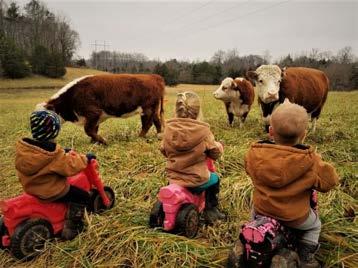
FROM SELF-SUFFICIENCY TO NATIONAL BEEF SALES
White Buffalo Ranch began as a father-and-son dream of creating a peaceful, self-sufficient farm life. However, their original goal of raising food for their family has evolved to include a growing beef business that ships farm-raised meat products across the United States.
The family currently sells beef in whole, half, quarter, and eighth portions, requiring deposits to secure orders and ensure fresh, high-quality meat is processed to order. But they’re not stopping there. By 2025, White Buffalo Ranch will process its first batch of mini Hereford beef, marking the beginning of a new chapter. “I’d love to stamp those packages with Certified Mini Hereford Beef,” exclaimed Kimberly, referring to the new marketing initiative rolled out by Mini Hereford Media, giving consumers confidence in the unique quality of the meat.
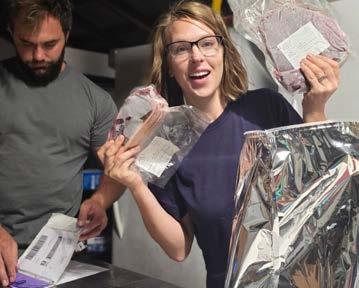
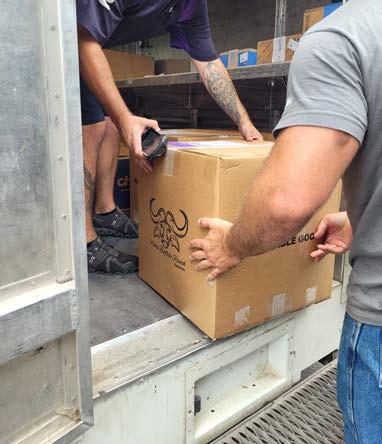
Looking ahead, the family plans to offer curated boxes of individual cuts as well as South African delicacies like boerewors (farmer’s sausage), droëwors (air-dried mini sausages), and biltong (air-dried jerky). These offerings showcase their heritage and reflect their mission to bring high-quality, diverse products to families nationwide.
Marketing Made Simple And Accessible
Marketing their mini Herefords is as much about connection as it is about cattle. White Buffalo Ranch employs a modern, accessible approach to reach a broad customer base. They use Facebook and Craigslist to showcase available animals and keep an open line of communication with potential buyers. Their website serves as a central hub for information and updates.
A unique selling point in their marketing is how easy their cattle are to handle. “All animals for sale are halter-broken, making it easier for new owners to handle them immediately,” Kimberly explains. Selling halter-broke cattle ensures a smooth transition for new owners and makes their cattle more approachable for families, beginners, and seasoned breeders. As a result, White Buffalo Ranch has become a trusted source for high-quality mini Herefords.
Advice For Aspiring Breeders
For those considering raising mini Herefords, the Oosthuizens offer timeless advice. “Be adaptable and resilient,” they stress, “have a solid plan, but also be ready to adjust as you learn more.” They encourage aspiring breeders to seek out mentors and build a support network.
Their experience highlights the importance of prioritizing health and quality over the competitiveness of the show ring. Early obstacles like building infrastructure and managing fencing taught them that success isn’t always fast—but it’s always worth it. They also emphasize the power of family support. As a family juggling ranching alongside other trucking jobs, the Oosthuizens know firsthand how crucial teamwork is to maintaining farm operations.
Vision For The Future
Looking ahead, White Buffalo Ranch envisions a future where mini Herefords are prized for more than just their place in the show ring. The family believes the breed’s potential as a sustainable food source is equally important. “I hope to see mini Herefords recognized not only in shows but also for the quality of their meat. It’s important for more people to experience and appreciate what Mini Herefords can offer, both as livestock and as a sustainable food source. If the Mini Hereford Breeders Association and breeders work together to get the word (and meat samples!) out, we can achieve the recognition the breed deserves,” Kimberly shared.
Education, advocacy, and—most importantly—taste tests will be essential to achieving this vision. Their upcoming 2025 launch of mini Hereford beef products will be a pivotal moment for the breed. By offering South African specialties like boerewors, droëwors, and biltong, White Buffalo Ranch will bring a new dimension to the market, blending culture, quality, and craftsmanship.
Their dedication to health, quality, and authenticity ensures they will remain champions of the breed. Just as the Oosthuizens stay true to their South African roots, they are equally committed to honoring the natural essence of mini Herefords. By embracing what makes both their family and their cattle unique—strength, resilience, and genuine character—they uphold the integrity of the breed. Through thoughtful breeding practices, they aim to protect and enhance mini Hereford genetics for generations to come, ensuring that authenticity remains at the heart of everything they do.
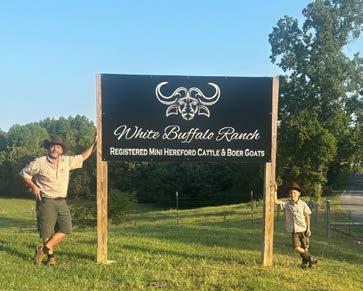
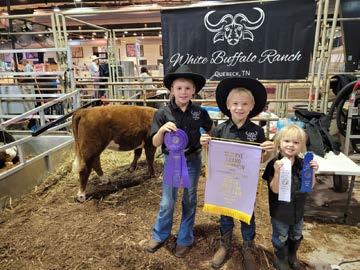
Beauty is in the eye of the be[ef]holder
Mini Herefords generally have a recognizable appearance, but breeders often develop specific preferences for their herds. “When selecting heifers or bulls, their appearance is our first consideration. We look for animals that exhibit strong, healthy characteristics. While pedigree is important, it’s not the sole factor. We strive to breed animals that stand out in both physical attributes and genetic quality,” shares Kimberly Oosthuizen.
At White Buffalo Ranch, these preferences include:
Polled or Horned? No preference!
Dark or Light Red? Medium to dark red
Frame Score Target? Frame 0-1 to align with our goals for breeding robust, well-sized animals suited to our farming practices and customer preferences.
Live breed, AI, or Embryo Transfer? We utilize AI with a champion bull for clean-up.
Ideal bull? Strong, masculine, sturdy on his feet (Our bull Kidd Fire resembles this for us right now!)
Ideal heifer? Feminine front end, ample room on the back end for ease of calving
Follow White Buffalo Ranch
As the Oosthuizens look to the future, they see growth, legacy, and sustainability at the heart of their mission. Their story reminds us that small beginnings can grow into something larger than imagined as long as the journey is guided by purpose, passion, and family unity.
To learn more about White Buffalo Ranch, visit their website at whitebuffalo-ranch.com or follow them on Facebook (@whitebuffaloranch.tn) and Instagram (@whitebuffaloranch2018).
